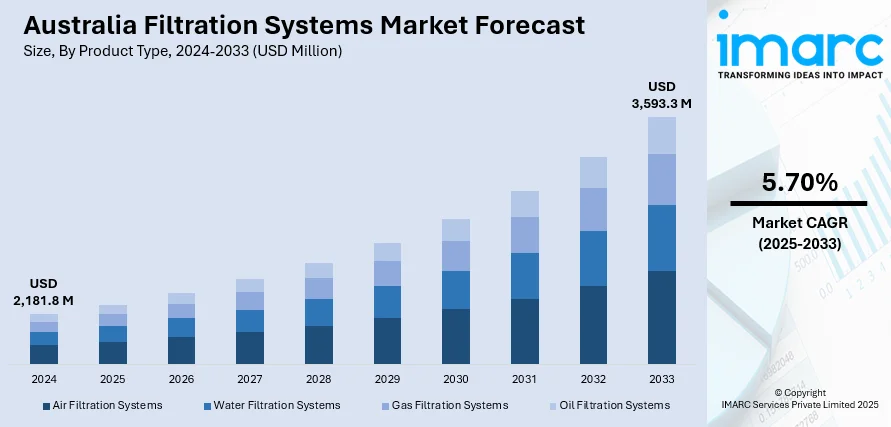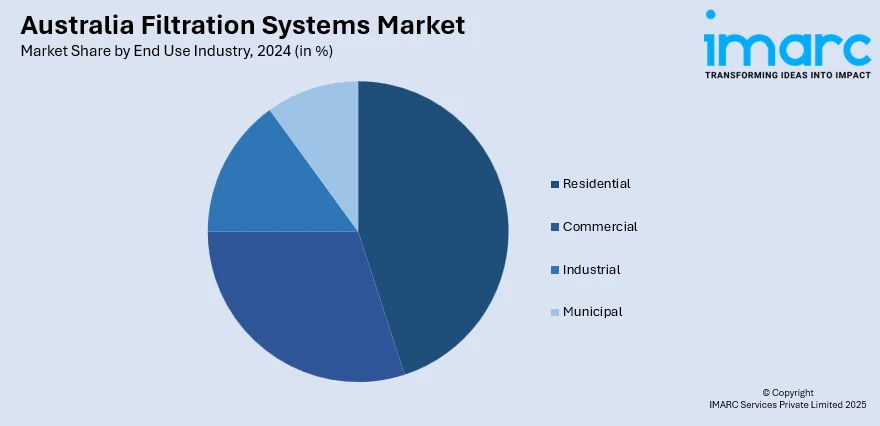
Australia Filtration Systems Market Size, Share, Trends and Forecast by Product Type, Filter Media, Technology, End Use Industry, and Region, 2025-2033
Australia Filtration Systems Market Overview:
The Australia filtration systems market size reached USD 2,181.8 Million in 2024. Looking forward, IMARC Group expects the market to reach USD 3,593.3 Million by 2033, exhibiting a growth rate (CAGR) of 5.70% during 2025-2033. The market is growing due to rising concerns about water quality, contamination, and environmental sustainability. Increasing awareness of health and hygiene is driving demand for advanced filtration systems in both residential and commercial sectors. Moreover, Australia filtration systems market share is expanding with innovative product launches.
|
Report Attribute
|
Key Statistics
|
|---|---|
|
Base Year
|
2024
|
|
Forecast Years
|
2025-2033
|
|
Historical Years
|
2019-2024
|
|
Market Size in 2024
|
USD 2,181.8 Million |
|
Market Forecast in 2033
|
USD 3,593.3 Million |
| Market Growth Rate 2025-2033 | 5.70% |
Australia Filtration Systems Market Trends:
Increasing Demand for Clean Water Solutions
Australia's market for filtration systems is growing strongly due to the demand for clean and safe drinking water. With the rising level of pollution and contamination, there is a need for good-quality water purification. Filtration systems such as reverse osmosis and new-age filtration technologies are being utilized by the residential sector as well as industry to counter the growing issue of contaminants in water. There has been increasing recognition of the value of water quality over recent years, particularly with the frequency of natural phenomena such as droughts and bushfires that can impact water supplies. With the increasing population and urbanization, there is an increased demand for effective and sustainable filtration systems throughout Australia. The demand for quality water solutions has prompted the innovation of efficient systems that serve residential and commercial demands. In October 2024, Brita, the leading water filtration company, launched a new series of commercial-grade water dispensers in Australia. These dispensers incorporated innovative filtration and hygiene technologies to enhance water quality in high-traffic environments such as offices and public places. This coincides with the general trend towards better health and water safety throughout the country. With all these advancements, the market for Australia filtration systems market growth is seeing a definite rise in adoption and is likely to maintain its upward trend.

To get more information on this market, Request Sample
Growing Focus on Environmental Sustainability
Environmental sustainability is now a major driver for the Australian filtration systems industry. With consumers and companies becoming increasingly environmentally aware, the need for green and sustainable filtration products has grown. Filtration systems that provide energy efficiency and less waste are now in very high demand on both the residential and commercial fronts. The growth of eco-friendly living and green technologies has spurred the need for filtration systems with an eco-friendly focus. Consumers and companies are turning to products that deliver quality water while being environmentally friendly. Filtration systems with longer lifespan filters, less energy consumption, and recyclability are gaining popularity. This trend will further fuel Australian filtration systems market growth because customers are increasingly becoming picky about the environmental impact of what they buy. The entry of high-tech products, like Conway's Airmega 100 air purifiers in Australia, reflects the direction of the market towards cleaner, greener, and more efficient solutions. They are manufactured with energy-saving features and recyclable materials to address the performance versus sustainability demand. With growing environmental issues, the market is likely to witness more innovation, creating further development and growth in the field of filtration systems.
Australia Filtration Systems Market Segmentation:
IMARC Group provides an analysis of the key trends in each segment of the market, along with forecasts at the country and regional level for 2025-2033. Our report has categorized the market based on product type, filter media, technology, and end use industry.
Product Type Insights:
- Air Filtration Systems
- Water Filtration Systems
- Gas Filtration Systems
- Oil Filtration Systems
The report has provided a detailed breakup and analysis of the market based on the product type. This includes air filtration systems, water filtration systems, gas filtration systems, and oil filtration systems.
Filter Media Insights:
- Activated Carbon
- Fiberglass
- Nonwoven Fabrics
- Metals
- Filter Paper
- Combination Filters
- Others
A detailed breakup and analysis of the market based on the filter media have also been provided in the report. This includes activated carbon, fiberglass, nonwoven fabrics, metals, filter paper, combination filters, and others.
Technology Insights:
- Microfiltration
- Ultrafiltration
- Nanofiltration
- Reverse Osmosis
- Electrodialysis
- Chromatography
- Centrifugation
The report has provided a detailed breakup and analysis of the market based on the technology. This includes microfiltration, ultrafiltration, nanofiltration, reverse osmosis, electrodialysis, chromatography, and centrifugation.
End Use Industry Insights:

- Residential
- Commercial
- Industrial
- Municipal
A detailed breakup and analysis of the market based on the end use industry have also been provided in the report. This includes residential, commercial, industrial, and municipal
Regional Insights:
- Australia Capital Territory and New South Wales
- Victoria and Tasmania
- Queensland
- Northern Territory and Southern Australia
- Western Australia
The report has also provided a comprehensive analysis of all the major regional markets, which include Australia Capital Territory and New South Wales, Victoria and Tasmania, Queensland, Northern Territory and Southern Australia, and Western Australia.
Competitive Landscape:
The market research report has also provided a comprehensive analysis of the competitive landscape. Competitive analysis such as market structure, key player positioning, top winning strategies, competitive dashboard, and company evaluation quadrant has been covered in the report. Also, detailed profiles of all major companies have been provided.
Australia Filtration Systems Market News:
- October 2024: Brita launched a new range of high-capacity commercial water dispensers in Australia. These dispensers, featuring advanced filtration and hygiene technologies, addressed the growing demand for sustainable, hygienic water solutions in high-traffic environments, significantly impacting the filtration systems market with innovative, reliable offerings.
- June 2024: Coway launched the Airmega 100, an affordable cylindrical air purifier designed for smaller spaces in Australia. Featuring 360-degree air intake and a 3-stage HEPA filtration system, it efficiently removes airborne pollutants, positively impacting the filtration systems market by offering a cost-effective solution for asthma and allergy sufferers.
Australia Filtration Systems Market Report Coverage:
| Report Features | Details |
|---|---|
| Base Year of the Analysis | 2024 |
| Historical Period | 2019-2024 |
| Forecast Period | 2025-2033 |
| Units | Million USD |
| Scope of the Report | Exploration of Historical Trends and Market Outlook, Industry Catalysts and Challenges, Segment-Wise Historical and Future Market Assessment:
|
| Product Types Covered | Air Filtration Systems, Water Filtration Systems, Gas Filtration Systems, Oil Filtration Systems |
| Filter Medias Covered | Activated Carbon, Fiberglass, Nonwoven Fabrics, Metals, Filter Paper, Combination Filters, Others |
| Technologies Covered | Microfiltration, Ultrafiltration, Nanofiltration, Reverse Osmosis, Electrodialysis, Chromatography, Centrifugation |
| End Use Industries Covered | Residential, Commercial, Industrial, Municipal |
| Regions Covered | Australia Capital Territory and New South Wales, Victoria and Tasmania, Queensland, Northern Territory and Southern Australia, Western Australia |
| Customization Scope | 10% Free Customization |
| Post-Sale Analyst Support | 10-12 Weeks |
| Delivery Format | PDF and Excel through Email (We can also provide the editable version of the report in PPT/Word format on special request) |
Key Questions Answered in This Report:
- How has the Australia filtration systems market performed so far and how will it perform in the coming years?
- What is the breakup of the Australia filtration systems market on the basis of product type?
- What is the breakup of the Australia filtration systems market on the basis of filter media?
- What is the breakup of the Australia filtration systems market on the basis of technology?
- What is the breakup of the Australia filtration systems market on the basis of end use industry?
- What is the breakup of the Australia filtration systems market on the basis of region?
- What are the various stages in the value chain of the Australia filtration systems market?
- What are the key driving factors and challenges in the Australia filtration systems market?
- What is the structure of the Australia filtration systems market and who are the key players?
- What is the degree of competition in the Australia filtration systems market?
Key Benefits for Stakeholders:
- IMARC’s industry report offers a comprehensive quantitative analysis of various market segments, historical and current market trends, market forecasts, and dynamics of the Australia filtration systems market from 2019-2033.
- The research report provides the latest information on the market drivers, challenges, and opportunities in the Australia filtration systems market.
- Porter's five forces analysis assist stakeholders in assessing the impact of new entrants, competitive rivalry, supplier power, buyer power, and the threat of substitution. It helps stakeholders to analyze the level of competition within the Australia filtration systems industry and its attractiveness.
- Competitive landscape allows stakeholders to understand their competitive environment and provides an insight into the current positions of key players in the market.
Need more help?
- Speak to our experienced analysts for insights on the current market scenarios.
- Include additional segments and countries to customize the report as per your requirement.
- Gain an unparalleled competitive advantage in your domain by understanding how to utilize the report and positively impacting your operations and revenue.
- For further assistance, please connect with our analysts.
 Request Customization
Request Customization
 Speak to an Analyst
Speak to an Analyst
 Request Brochure
Request Brochure
 Inquire Before Buying
Inquire Before Buying




.webp)




.webp)












